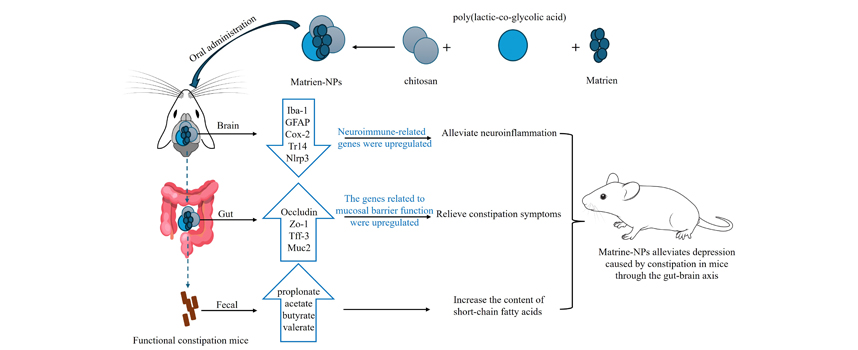2025 Volume No 53 – pages 1-14
Title: Matrine nanoparticles improve functional constipation and associated depressive behavioral disorders by modulating the gut-brain axis |
Authors: J Liu, SK Mu, JX Gao, XY Yan |
Address: Department of Geriatric Medicine, Affiliated Hospital of Shandong University of Traditional Chinese Medicine, 250011 Jinan, Shandong, China |
E-mail: sharon.yan at 163.com |
Abstract: Background: Functional constipation (FC) in the elderly is associated with depressive behavior. Matrine is a bioactive alkaloid with anti-inflammatory properties, promoting intestinal motility and gut barrier function. This study aimed to investigate how chitosan/matrine-poly(lactic-co-glycolic acid) nanoparticles (matrine NPs) alleviate depression in elderly mice with FC induced by loperamide (Lop). Methods: Matrine NPs were prepared, and their physical and chemical properties were determined by scanning electron microscopy, dynamic light scattering, and ultraviolet spectrophotometry. A Lop-induced FC model was established in C57BL/6J mice, and hematoxylin and eosin staining was used to assess inflammation and structural damage in colon tissue and hippocampus. The expression levels of occludin in colon tissue and ionized calcium binding adapter molecule 1 in the hippocampus were determined by immunohistochemistry. Enzyme-linked immunosorbent assay was employed to measure the levels of lipopolysaccharide, 5-hydroxytryptamine, and γ-aminobutyric acid in serum. The expression levels of genes related to gut barrier function and mucus secretion in the colon tissue, as well as genes related to inflammation and neuroimmune regulation in the hippocampus, were determined by quantitative reverse transcription polymerase chain reaction. The levels of short-chain fatty acid (SCFA) metabolites in mouse feces were measured using gas chromatography. The antidepressant effects of matrine NPs were evaluated through behavioral tests. Results: The release rate of matrine NPs reached 81.22 % in a simulated gastrointestinal environment. The drug loading (DL) and encapsulation efficiency (EE) of matrine NPs were 80.66 % ± 4.18 % and 69.37 % ± 2.86 %, respectively. Matrine NPs alleviated constipation symptoms, upregulated the expression of occludin in colon tissue, and effectively prevented gut barrier damage (p < 0.001). They also lessened anxiety and depression-like behaviors in FC mice by reducing synaptic degeneration and neuroinflammation (p < 0.001). Moreover, matrine NPs increased the levels of SCFAs in the feces (p < 0.001). Conclusions: The intake of matrine NPs alleviates depression caused by constipation in mice through the gut-brain axis. |
Keywords: Matrine, gut-brain axis, functional constipation. |
Publication date: 30th September 2025 |
Copyright policy: © 2025 The Author(s). Published by Forum Multimedia Publishing, LLC. This article is distributed in accordance with Creative Commons Attribution Licence (http://creativecommons.org/licenses/by/4.0/). |
Article download: Pages 1-14 (PDF file) |

